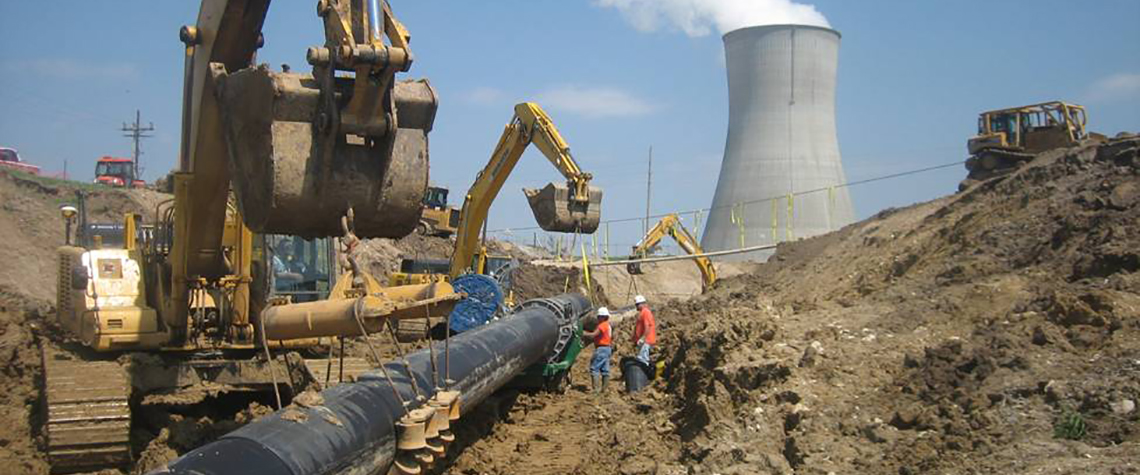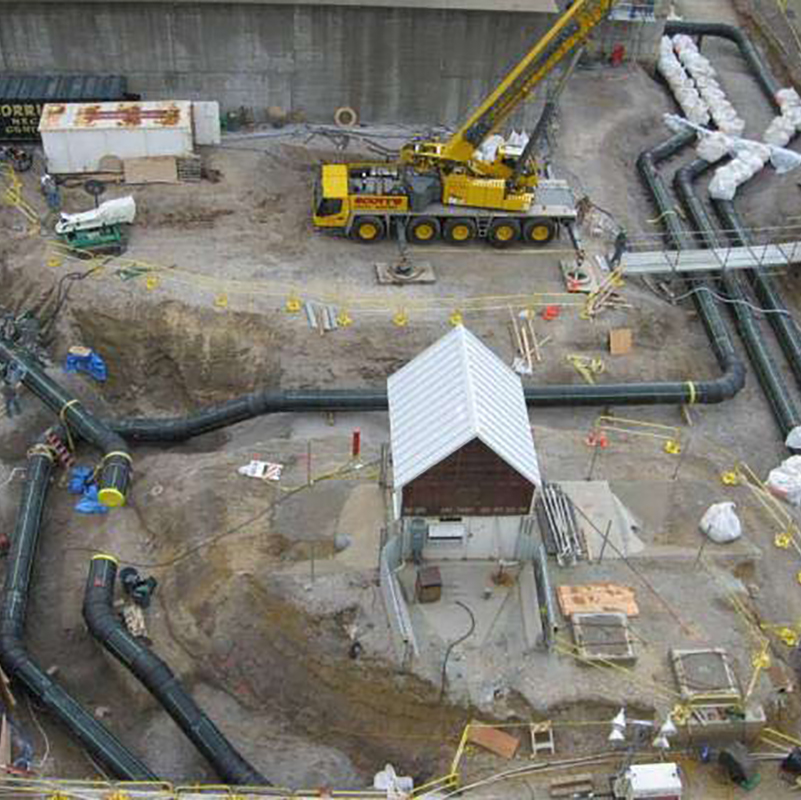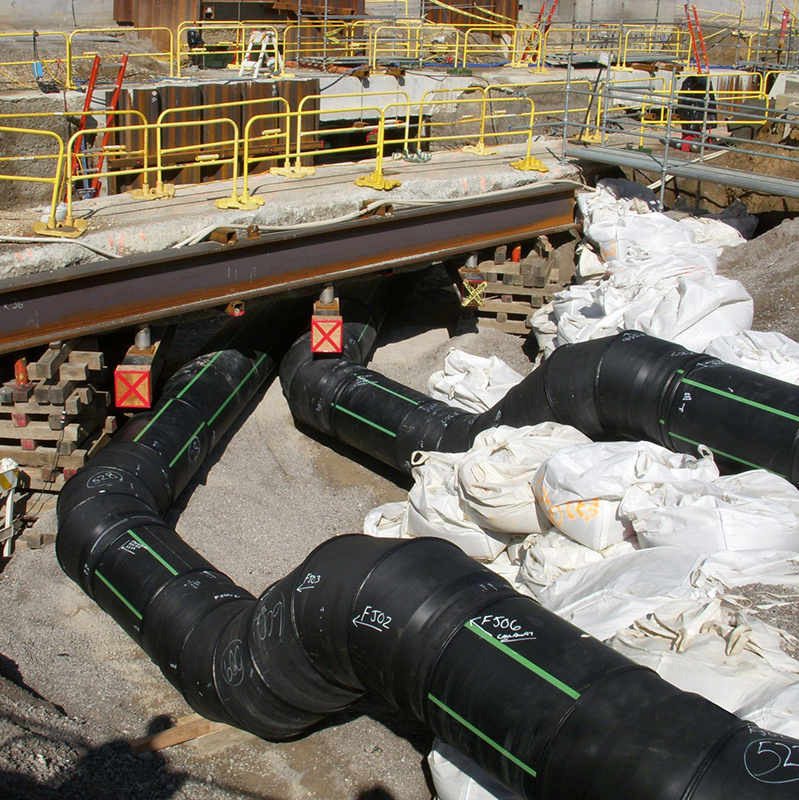
The AmerenUE Callaway nuclear plant, located about 25 miles northeast of Jefferson City, Missouri in Callaway County had a potential problem. Two carbon steel piping systems critical to the operation of the plant needed to be replaced due to the long term effects of corrosion.
The AmerenUE Callaway Nuclear Plant has provided safe, clean and affordable electricity for more than 20 years. Nuclear energy is America’s largest source of clean-air, carbon-free electricity producing no green house gases or air pollutants. The power generated by the Callaway Plant provides electricity to 780,000 average households each year. Needless to say, thousands of families live comfortably due to the reliable operation of the Callaway nuclear plant.
High Density Polyethylene (HDPE) pipe has been used in different capacities at AmerenUE coalfired generation plants for many years. These past experiences have allowed AmerenUE engineers to witness the long-term benefits HDPE pipe provides. ISCO Industries, the nation’s leader in HDPE piping systems, was called upon to offer expertise and insight into finding an HDPE solution to both of AmerenUE Callaway Nuclear Plant’s piping issues. The ISCO Industries team, led by Shane Schuessler, Missouri Sales Manager, and Dudley Burwell, Vice President - Corporate Quality, worked closely with AmerenUE as well as consulting engineers to provide solutions. Two years and over 40,000 feet of large diameter pipe later, Callaway has completed the two projects to ensure the safe and reliable operation of the plant.

Project 1 - Cooling Tower Blow Down
The first project needing attention was the large diameter “blow-down line”. This pipe is used to carry water from the large cooling tower at the Callaway plant to the Missouri River. The project called for the installation of 38,000 feet of 36-inch IPS DR 17 PE 3408 HDPE pipe. The design of this project presented some challenges including a large elevation change and burial conditions exceeding 25 feet in depth. Schuessler and Burwell provided solutions to these issues as well as others and the project proceeded from design to installation.
ISCO supplied all pipe, fittings and equipment for this project. Bloomsdale Excavating of Bloomsdale, Missouri was the principal contractor for the project. They used a McElroy Trac900 unit which was rented from ISCO Industries to fuse the pipe. During installation several additions/modifications to the system were made. ISCO fusion technicians, including Schuessler, provided on-site installation assistance. All excavation, pipe burial, connections, and testing were completed in 14 months.
Project 2 - Essential Service Water (ESW)
For more than 25 years HDPE pipe made from PE 3408 pipe-grade resins have provided long-term solutions to many of the power industries’ piping needs. Recent advances in HDPE resins have increased the engineering characteristics of the material. The upgraded resin, PE 4710, offers superior slow crack resistance, excellent abrasion resistance and higher working pressure capability to name a few of the improved characteristics. The use of PE 4710 resin to make HDPE pipe was approved for industrial applications in 2007 under ASTM F 714.
AmerenUE Callaway plant engineers needed to replace approximately 2000 feet of 30-inch carbon steel pipe used as their Essential Service Water (ESW) system for the plant. Similar to the original steel blow-down line which was installed in the 1980s, the 30-inch ESW carbon steel pipe had reached the end of its useful life due to internal corrosion of the pipe wall. Time was a major factor in the replacement of the line and long lead times for ASME Class III steel pipe put project completion past Callaway’s installation window. AmerenUE engineers were looking for options. Because of the successful ongoing installation of the 36” HDPE blow-down line, AmerenUE engineers and project managers were interested in the use of HDPE pipe to solve their ESW line issue. PE 4710 HDPE pipe was discussed during a presentation by Steve Sandstrum, Director of Business Development, and Shane Schuessler, both with ISCO Industries. One major hurdle existed – approval of PE 4710 HDPE pipe by ASME and the Nuclear Regulatory Commission (NRC).
The ESW line was a replacement project occurring between buildings in the secure area of the Callaway Nuclear Plant and is an ASME Section III, Division 1; Class 3 buried water piping system. This line replacement was the first such HDPE piping installation of its kind in the United States and included 2000 feet of 36-inch IPS DR 9.5 PE 4710 HDPE pipe. Because the replacement project involved a safety system of the Callaway plant, the NRC had to approve the use of HDPE in such an application. A group of qualified experts in ASME Class 3 piping systems including AmerenUE engineers and engineering consultants worked to create ASME Code Case N-755. Dudley Burwell of ISCO Industries was included in the group as the HDPE expert and was an integral part of the team to get acceptance of the code case. ASME Code Case N-755 covers the use of HDPE materials in ASME Class 3 water piping systems. It outlines system design, training, fabrication, installation, examination and testing. Approval within ASME was reached on Code Case N-755 in 2007. The technical information in Code Case N-755 became the basis for Callaway’s request to the NRC (and ultimate approval) for use of the HDPE in an ASME Section III, Class 3 system. ASME’s approval of Code Case N-755 provides the opportunity for nuclear power facilities across the United States to obtain NRC approval and receive the long term advantages of HDPE pipe in buried systems.
Installation of AmerenUE Callaway plant’s ESW piping system presented several complex challenges including a short installation timing window, numerous physical obstacles above and below grade, and the unfamiliarity with HDPE pipe fusion and installation. Once again, ISCO Industries provided training, supplied the pipe and fittings, and provided the McElroy fusion equipment for this project. Corrigan Company, a mechanical contractor based in St. Louis, Missouri, was the installing contractor for the ESW line replacement while Bloomsdale Excavating completed the excavation and backfill work. On-site training started in June 2008 and the lines were installed and hydro-tested by December 2008. One train of the new piping was tied-in and made operational in December 2008. The second train became operational in April 2009.

The ISCO Advantage - Project Consultation and Coordination
Both projects required a great amount of engineering and coordination. ISCO Industries provided technical expertise on both projects. Frank Schaaf, a consultant with many years of experience in the nuclear power industry, was brought on board for the ESW line project. He and ISCO Industries’ Dudley Burwell were instrumental members of the group that created Code Case N-755 to allow the use of HDPE pipe in ASME Class 3 water applications within nuclear plants. Schaaf and Burwell also conducted the required surveys at the HDPE pipe manufacturing plant making the 36-inch DR 9.5 PE 4710 HDPE pipe.
Pipe and Fittings – In addition to supplying pipe for both projects, ISCO Industries fabricated HDPE elbows and tees for the blow-down line. ISCO Industries also coordinated the fabrication of the PE 4710 thick-walled externally reinforced elbows for the ESW line which were required to meet system requirements. This also included some pre-fabricated sections of pipe and fittings.
Fusion Joining Equipment and Training – ISCO Industries’ Shane Schuessler conducted an on-site fusion training session with Bloomsdale Excavating using a McElroy Trac900 unit. This unit was chosen for the blow-down line installation.
For the ESW line installation ISCO provided fusion machines and extensive training to AmerenUE personnel including engineers and inspectors. Also trained were ASME personnel and Corrigan Company project managers and pipe fitters. Four McElroy Trac900 units along with McElroy Dataloggers (data collecting PDA’s) were used to complete the project. Due to numerous obstacles in the pipe installation area, many fusions were made in the trenches.
Troubleshooting and Compliance – During the beginning stages of fusion training, the McElroy Datalogger PDA’s were having trouble with their wireless feature. It was discovered that the high voltage power lines coming from the power plant were causing electromagnetic field interference. ISCO Industries, as well as McElroy experts, worked to resolve the issue with the assistance of Corrigan Company pipe fitters.
As part of the compliance with the ESW line, crosssections of the fused HDPE pipe had to be tested to ensure joint integrity. The reinforced fitting manufacturer, Dudley Burwell and Frank Schaaf all provided input as to testing of the samples and the apparatus to be used. Testing of the samples proved to be a success both for material and joint integrity.
The Bottom Line -- ISCO Industries has been offering HDPE piping solutions for over 40 years. ISCO Industries leadership in HDPE piping systems offered the project managers and engineers involved with both projects the confidence needed to proceed with HDPE. Both projects produced unforeseen challenges; however, with the experience of ISCO Industries and all others involved, these challenges were met head-on and resolved.
The completion and approval of ASME Code Case N-755 along with the use of PE 4710 HDPE pipe in an ASME Class 3 piping system were both groundbreaking events that involved many people and countless hours. The ESW line replacement was historic in that a project of its kind had never been attempted or completed before in the United States. Nuclear facilities around the country have had a door opened to them that can provide long-term solutions to current and real piping problems allowing them to continue the nuclear power tradition of safe, clean, reliable, and affordable electricity.
SUBSCRIBE TO ISCO UPDATES
ISCO Updates
[gravityform id="21" title="true"]
